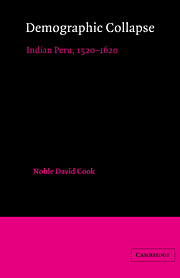Part II - Demographic collapse
Published online by Cambridge University Press: 02 December 2009
Summary
The point to be stressed here is the obvious one that this relationship between the size of a population and the organization of that population is such that a drastic reduction of the population size undermines the existing social organization in virtually all its aspects. Thus a case of so-called cultural devolution may be attributable to nothing more complex than extensive depopulation caused by elements beyond the immediate control of the society involved.
D. E. Dumond, “Population Growth and Cultural Change,” pp. 319–20In the preceding pages we attempted to gauge the magnitude of Peru's preconquest population. By any standards the Inca population was large. Perhaps 9 million people resided within the limits delineated by Peru's contemporary boundaries. The number of inhabitants remaining a century after contact was roughly a tenth of those that were there when the Europeans invaded the Andean world. In the following chapters we shall examine the transformations that were taking place as a result of the demographic collapse of native America. The impact of population change varied from one place to another within Peru. Some Indian communities were wiped out. In a few cases numbers actually increased, in spite of the general downward tendency. We shall examine these developments in as great detail as possible. Analysis is within the framework of major geographical regions. We have already seen the differences between coastal and highland change. More subtle variations are discernible as one moves southward, down the Peruvian coast. Although on occasion such a structure becomes too rigid, the results are useful for comparative analysis.
- Type
- Chapter
- Information
- Demographic CollapseIndian Peru, 1520–1620, pp. 115 - 118Publisher: Cambridge University PressPrint publication year: 1982



